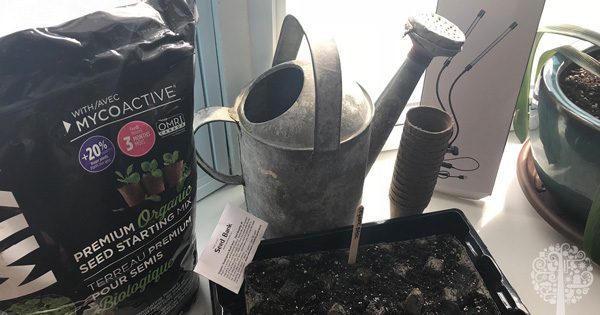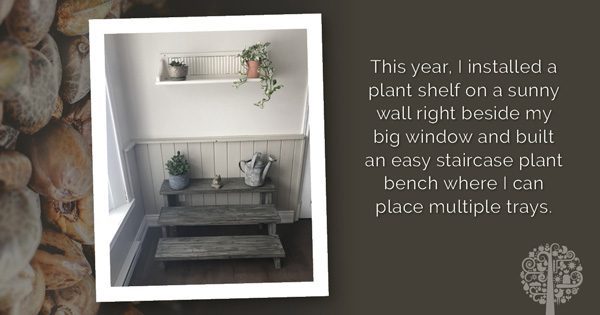The mountains of snow outside may not seem to be getting any smaller, but the days are getting longer, meaning both spring and seed-starting days are just around the corner!
While it still may be a tad too early yet to start most seeds for the garden, now is an excellent time to consider what you want to grow, how much space you’ll need, and the tools needed to get started.
A wonderful resource to look at is Julie Thompson-Adolf’s Starting & Saving Seeds: Grow The Perfect Vegetables, Fruits, Herbs, and Flowers for your Garden. This book is a helpful guide for gardeners of all skill levels but makes potentially intimidating tasks easier for beginners. Much of the following information comes from it, and so much more, including the art of saving seeds.
Why Start Your Seeds?
Starting seeds is great for so many reasons, but most of all, while the weather outside is still frightful, you can be indoors getting your hands dirty and a much-needed headstart on your summer gardens.
Variety. Browse through any seed catalog or online seed bank, and you’ll notice just how much variety is out there. Most local nurseries carry only the basic plant varieties but do a little digging, and you can find seeds that will grow fruits, veggies, and flowers of all different shapes, colors, patterns, tastes, and textures. The same is true for cultural backgrounds; the possibilities are endless!
Control. Another advantage starting seeds offers is knowing exactly how your plants have been grown from beginning to end, especially helpful when aiming to make your yard or balcony into an organic oasis. Starting seeds means you control everything from the type of seed being used to the soil it’s being grown in and what it’s being fed.
Money. You’ll also save a tremendous amount of money when starting your seeds. Instead of spending a lot on flats of plants at greenhouses, it’ll cost you only a few dollars per seed packet, plus materials.
Seed Types
After taking time and space into consideration and choosing what plants you want to grow, it’s time to buy your seeds.

There are many different types available to home gardeners, so as Thompson-Adolf points out in her book, here are a few terms you should be aware of when seed shopping:
- Open-pollinated: Pollination of these seeds is performed by people, insects, birds, wind, and other natural sources. If pollinated within the same species, plants will produce seeds similar to the parents.
- Heirloom: Some associate these seeds with a plant that has been cultivated for 50 years or longer. Others associate heirloom varieties with heritage and history they can trace back to a family or region. These seeds are also open-pollinated.
- Hybrid: These seeds have been created by breeders to include desired traits from different plant parents such as higher yields, increased pest resistance, and so on.
- Organic: Gardeners can rest assured that certified organic seeds have been collected only from plants that are free from all chemicals and nonorganic fertilizers.
Supply List
After you’ve bought your seeds, you’ll need several tools and materials before the sowing process begins:
- Seed-starting flats with individual cells or recycled ones such as egg cartons, yogurt or strawberry containers, etc. Make sure the recycled options have drainage holes and that you also have a tray to sit underneath the flats.
- Clear domes for the propagation trays.
- Grow lights are always a good idea, as natural light that hits the windowsill isn’t always sufficient. Make sure they have a timer, and if they don’t, plug them into one.
- Waterproof heat mats are also a great idea, as seeds germinate better when the soil temperature is optimal.
- A spray bottle and watering can.
- Plant tags so you can keep track of what you’re growing in each flat.
- Seed-starting mix and potting soil.
- A shovel or cup so you can scoop the soil you’re using.
Make sure you have the space available to start your seeds. In the past, I’ve crowded every windowsill of the house with seedlings, even going as far as placing flats on the floor near my south-facing windows.

This year, I installed a plant shelf on a sunny wall right beside my big window and built an easy staircase plant bench where I can place multiple trays. Once I transplant my seedlings outdoors, the bench will be a perfect place to showcase my houseplants. I have an electrical socket nearby so I can plug in some grow lights.
Remember, Timing Is Everything!
Once you’ve got all of your seeds and supplies, it can be tempting to get planting right away.
But be aware that if you start your seeds too early, your plants will likely end up being very leggy and overgrown. Wait too long, and you won’t enjoy the fruits of your labor until the growing season is almost over, or not at all.
For warm-weather crops, find out when the last frost date is in the spring and count backward to plan when the seeds should be sown. While some plants like cucumbers and melons can be sown indoors just three to four weeks before the last frost, others, like peppers and tomatoes, need a jumpstart of about eight weeks before they can be planted outside.
Starting seeds involves a lot of thought, time, and energy, but is incredibly satisfying, especially when it comes time to enjoy the beautiful blooms or harvest.